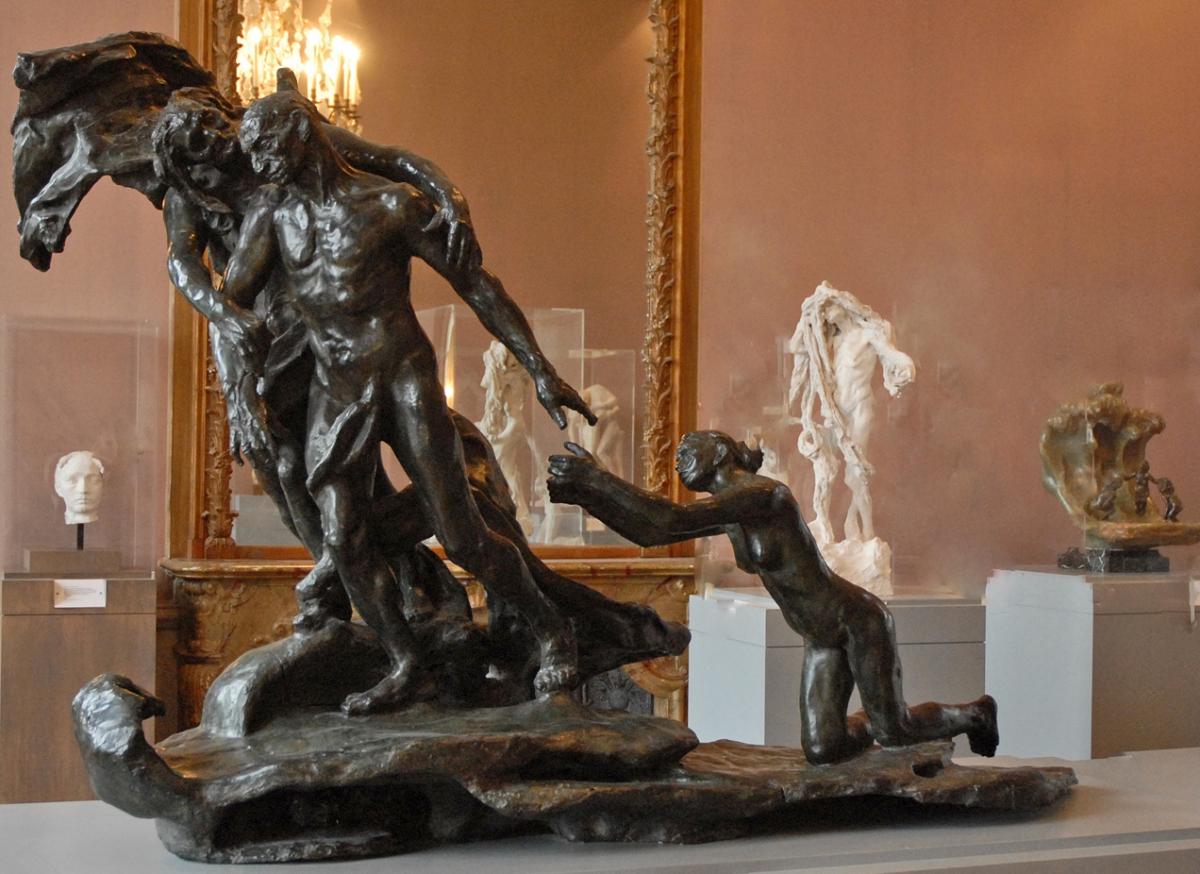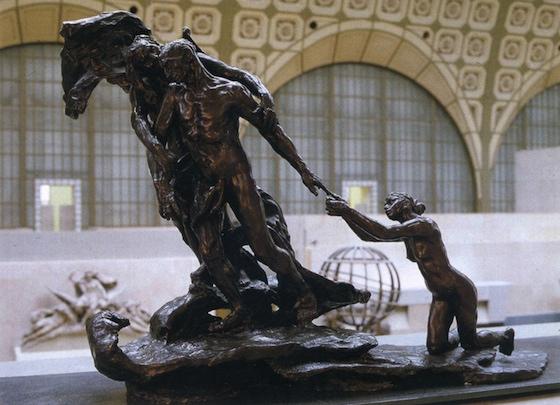Camille Claudel (1864-1943) was born in the Aisne region of northern France into a family of priests, farmers, and the gentry. Her father was a banker. From 1869 until 1876, Claudel was educated at the school run by of Sisters of Christian Doctrine. The family moved to Paris when Claudel was seventeen years old. She showed a strong interest in art, but her mother disapproved of her “unladylike desire to become an artist.” Her father was more encouraging and showed her work to the sculptor Alfred Boucher, who said she was talented and should be encouraged.
Claudel began to study with Boucher in 1881 at the Academie Colarossi, a progressive school. Female students were accepted and even allowed to work from nude male models. In 1882 Claudel rented a studio with Jessie Lipscomb and two other women sculptors. Boucher won the Prix de Rome, an Academy prize that allowed the winner to study in Italy for a number of years. Before leaving he asked fellow sculptor August Rodin to look at Claudel’s work. She began working in his studio in 1883; she was his student, his model, his muse, and eventually became his lover, although he had a life-long partner Rose Beuret.
Claudel and Rodin had a passionate love affair from 1883 until 1891, when their relationship began to deteriorate. Claudel’s family disapproval of her life style, and she was forced to leave the family. Claudel had an abortion in 1892. She ended the affair and moved into her own studio. Claudel and Rodin continued to work together and to see each other until 1898. He famously claimed, “I have shown her where to find the gold in art, but the gold she has found was in herself.”
Claudel was successful as a sculptor, and in 1891 she was selected to be a jurist at the National Society of Fine Arts. Her first plaster model of “The Waltz” was reviewed in 1892 by art critic Armond Dayot, who was working as an inspector for the French Ministry of Beaux-Arts. The figures were originally two nudes, and Dayot found the movement and modeling praiseworthy. However, he found it not appropriate for public display.
Claudel reworked “The Waltz” (1893) by draping the lower torso of the female with an elegant flowing skirt. Dayot described the additions as “a gracious intertwining of superb shapes balanced in a harmonious rhythm among swirling drapes.” He stated that Claudel had great talent. However, when “The Waltz” was presented to the 1893 Salon of the Société National des Beaux-Arts, the authorities criticized its “violent sense of reality” and dismissed it. Claudel made several adjustments to the model over many years. The man once kissed the neck of his partner, but in this piece he gently kisses her cheek.
“The Waltz” (1905) is considered by art historians to be one of Claudel’s most personal works. Like most of Claudel’s sculptures, the work was not cast into bronze until 1905. However, the subject was influenced by her relationship and possible affair with the composer Claude Debussy. The two shared several interests in common, and music historians often speculate which of Debussy’s musical works were directly influenced by the relationship. After Claudel ended the relationship, Debussy wrote: “I weep for the disappearance of the Dream of his (the male figure) Dream.” Debussy kept a small model of “The Waltz” on his piano until his death.
Claudel and Debussy both admired the work of Degas and of the Japanese Ukiyo printmaker Hokusai. “The Wave” by Hokusai inspired Claudel’s “The Wave” (1897) (onyx, bronze, marble) (24.5’’ x22.2’’). In her work three female figures, cast in bronze, hold onto each other as the wave, carved from onyx, is about to crash over them. Not often employed by sculptors, the use of multiple media adds color to the work. The yellows, greens, and browns of the onyx also reference the colors in Hokusai’s print. The work may speak to the dark destiny of drowning; however, it may also be seen as women frolicking in the waves. Combined with ”The Gossips” (1897), a multimedia work of similar design and composition, the subject matter is lighter. Her use of multimedia may be inspired by the sculptures of Charles Cordier, a popular contemporary sculptor, who used multicolored marbles.
The plaster model for “Perseus and the Gorgon” (1897) (77’’x 43.7’’ x 35.4’’) was exhibited in the Salon de la Société National des Beaux-Arts in 1899. Rodin continued to aid Claudel financially, and he negotiated with the director of the Société to allow Claudel to show this piece in the 1899 Salon. Claudel hoped the model would lead to a commission. The Countess Arthur de Maigret commissioned a marble copy for her mansion in Paris. The work took four years to complete. Claudel was assisted by Francois Pompon who worked in their studio from 1890-1895. The marble sculpture was presented at the 1902 Salon. Unfortunately, the commission for the marble sculpture had been cancelled as a result of Rodin’s withdrawal of support because he was angered at seeing Claudel’s sculpture “The Age of Maturity.”
Claudel’s selection of a subject from Greek mythology, rather than a theme of her own creation, was likely a result of her financial struggles. Perseus and the Gorgon was typically an Academy subject. The young Perseus was tasked with bringing back the head of Medusa, the monster whose hair was made of snakes and who instantly turned anyone who looked upon her to stone. He was assisted in this task by several of the Olympian gods; Athena gave him a shield, Hermes gave him winged sandals so he could fly a long distance to find her, Hades gave him a cloak of invisibility, and Hephaestus gave him a sword. Claudel depicts Perseus looking into the mirrored surface of the shield to see Medusa, rather than looking directly at her and being turned to stone. The dead body of Medusa lies at Perseus’s feet. From her severed neck were born two miraculous animals. One was the winged horse Pegasus whose wings Claudel depicts as the horse is being formed.
Dating any of Claudel’s sculpture is difficult, as many were conceived and altered over her working lifetime. Claudel started all in plaster, and made copies in marble and bronze. Others were cast in bronze by Eugene Blot in 1905. “The Age of Maturity” (1893-1900) shocked and angered Rodin when he viewed it in 1899. Claudel wrote, “One day when Rodin was visiting me, he suddenly stood still in front of this portrait, contemplating it, gently caressing the metal and weeping…” There are several ways to interpret the entire work. Some believe the first two figures represented a middle-aged man wrestling with the figure of old age, fighting against destiny. Is the young female, originally a separate work titled “The Implorer” (1898), pleading with old age to let the younger man go? Or is this a highly personal representation of their tempestuous love affair? Or, is old age not represented by a male but a female, specifically Rose Beuret, who Rodin chose over Claudel? Or does it have others meanings?
“The Age of Maturity” is full of passion, no matter the interpretation, and Claudel’s modeling of the surface is superb. The ripeness and softness of the young woman’s skin is an immediate contrast to the stretched neck tendons, sagging skin, and blood vessels and bones of the middle-aged man’s chest and hand. The face of the old man is a mask of death. This Claudel masterpiece was cast in bronze in 1902, and can be seen in a life-size model in the vast turbine hall of the Musee D’Orsay (first two figures 64’’ tall, single female figure 45” tall). From 1894 until 1898, Claudel had the single female, “The Implorer” (1898) cast into an edition of 59 copies.
Claudel exhibited at the 1903 Salon d’Autumne, an exhibition at the Salon des Artistes Francais. However, she was seen wandering the town, prowling around Rodin’s villa, disappearing for long periods of time, and showing signs of paranoia and schizophrenia. Claudel destroyed many of her works. By 1906, she was living in seclusion in her studio. Her family had never approved her behavior, but her father had always supported her. When he died in March 1913, she was not told of his death. Eight days later, her younger brother Paul admitted her to a psychiatric hospital. If she was able to work, she was fine according to hospital records. She wrote, “I have fallen into an abyss. I live in a world so curious, so strange. Of the dream that was my life, this is my nightmare.” The Paris press, calling her a sculptor of genius, tried in vain to help her.
During the German advance on Paris, Claudel was transferred to another mental asylum farther from Paris. The admittance certificate, dated September 22, 1914, stated she suffered “from a systematic persecution delirium mostly based upon false interpretations and imagination.” Claudel’s mother prevented her from receiving any mail, except from her brother. On several occasions doctors encouraged her mother to have Claudel released. Her mother refused. Over the 30 years of her confinement, her brother Paul visited her just seven times. Her sister Louise visited once. Her mother, who died in 1929, never visited. Fellow sculptor and friend Jessie Lipscomb visited, insisting Claudel was not insane. Camille Claudel died on of an apoplectic stroke on October 19, 1943. She was buried in a communal grave with the bones of destitute persons. The location of her gravesite remains unknown.
The Camille Claudel Museum in Nogent-sur-Seine was opened in 2017. Approximately 90 statues, sketches, and drawings survive. Twenty additional works from the private collection of Claudel’s sister Louise were sold for $4.1 million in 2017. Rodin and Rose Beuret had a relationship from 1864 until February 1917, when they married. They had one child. Rose died two weeks later. Rodin died on November 17, 1917.
Two of Claudel’s contemporaries, Octave Mirabeau and Louis Vauxcelles, both respected art critics, praised Claudel’s work. Mirabeau called her “a revolt against nature: a woman genius.” Vauxcelles described her as “the only sculptress on whose forehead shone the sign of genius, more virile than many of her male colleagues.”
Beverly Hall Smith was a professor of art history for 40 years. Since retiring with her husband Kurt to Chestertown in 2014, she has taught art history classes at WC-ALL. She is also an artist whose work is sometimes in exhibitions at Chestertown RiverArts and she paints sets for the Garfield Center for the Arts.











Bettye W says
Wow! Thank you so much for this article. Camille Claudel is one of my favorite artist of all time. There are two amazing movies on her life – one stars Isabelle Adjani and the other Juliette Binoche. I highly recommend the first one which can be found on YouTube.